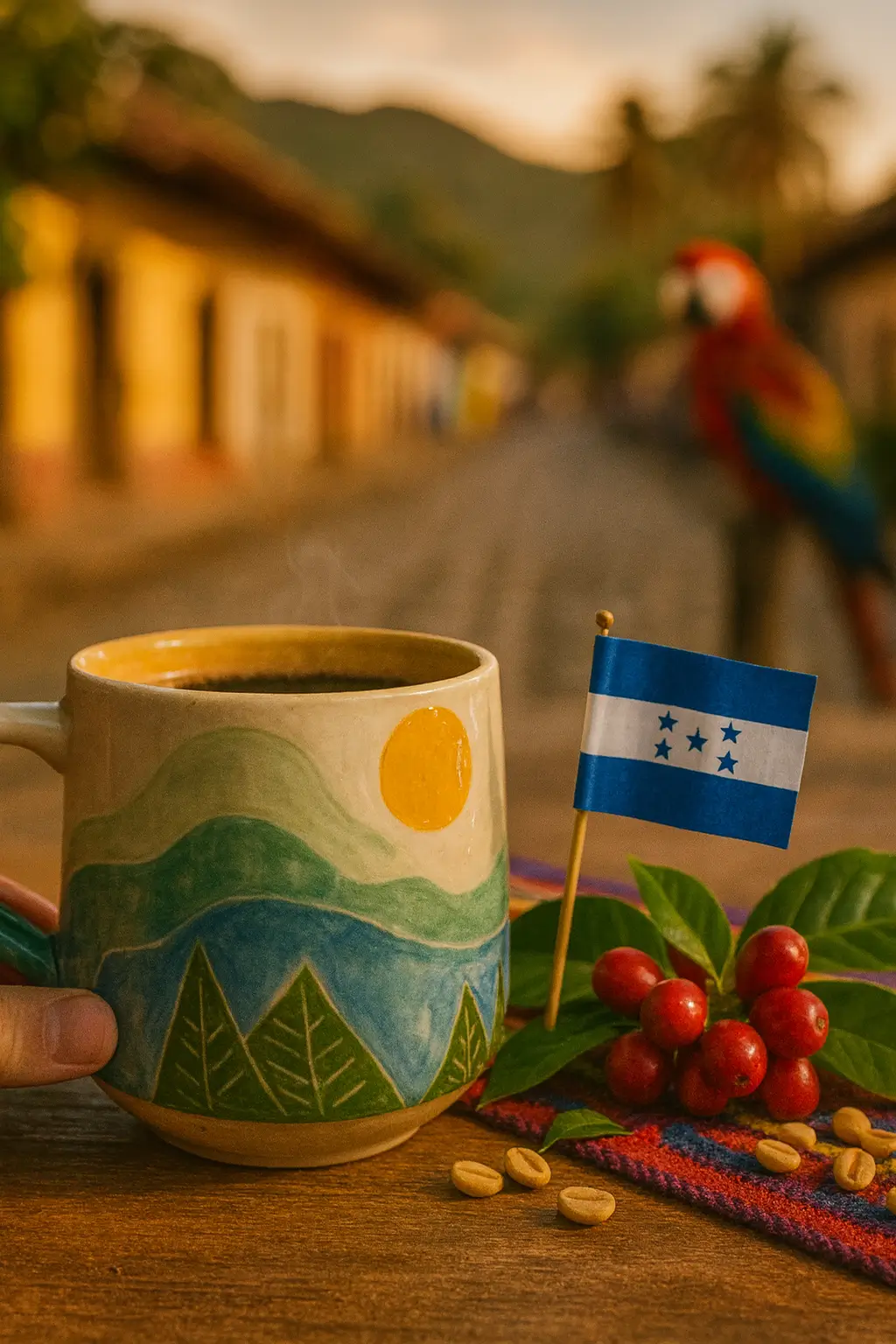Honduras coffee captures global attention. This Central American country steadily earns recognition for its special qualities. You’ll find a remarkably balanced flavor profile, with distinct notes and nuanced complexities. The diverse flavors come from its amazing terroir, which means varying altitudes, rich soils, and unique microclimates across the country.
- What makes Honduras coffee unique?
- Honduras coffee’s diverse terroir and key growing regions
- Coffee varieties of Honduras: A taste of diversity
- How do processing methods shape the flavor of Honduran coffee?
- The journey of Honduran coffee: From local crop to global powerhouse
- The position of Honduran coffee on the global stage
- How to brew the perfect cup of Honduras coffee?
We will explore Honduras coffee’s rich history and key growing regions. We’ll look at the diverse varieties grown there and the processing methods that create its distinct taste. You will also learn about its growing global standing.
What makes Honduras coffee unique?
Honduras coffee usually offers a delightful flavor profile. It has a medium body, lively to medium acidity, and a smooth, clean finish. This combination creates a consistently pleasant cup for many coffee drinkers. Its balance makes it a versatile choice for various brewing methods.
Common taste notes in Honduran coffee include rich chocolate, sweet caramel, and distinct nutty tones. These core flavors often form the coffee’s backbone. Beyond these, many fruity characteristics add more complexity.
You might notice hints of berry, bright citrus, or exotic tropical fruits. Sometimes, you can even detect intriguing wine-like characteristics. These notes vary by specific region and the processing method used.
Honduras coffee’s diverse terroir and key growing regions
Honduras’s diverse terroir includes high altitudes, fertile volcanic soils, and distinct microclimates. These factors shape the unique qualities of its coffee. They provide ideal conditions for growing high-quality Arabica beans. Coffee plants thrive in these mountainous areas, benefiting from consistent rainfall and moderate temperatures.
The main coffee regions include Copán, Opalaca, Montecillos, El Paraíso, Agalta, Comayagua, Marcala, and Ocotepeque. Most of these regions sit between 1,000 and 1,600 meters above sea level. This elevation allows coffee cherries to mature slowly. Slow maturation concentrates their sugars, resulting in denser, more flavorful beans.
What are the characteristics of Copán Honduras coffee?
The Copán region sits in western Honduras, bordering Guatemala. It produces coffee with a distinct flavor profile. Altitudes here range from 1,000 to 1,500 meters, creating unique characteristics. This region is one of the coolest in Honduras, often experiencing periodic low temperatures around 11ºC and high humidity.
Coffee from Copán offers a sweet aroma. You’ll find notes of chocolate, caramel, and citrus. These coffees also show beautifully balanced acidity. Common varieties grown in Copán include Bourbon, Caturra, and Catuai.
What flavor profile does Opalaca Honduras coffee offer?
Opalaca coffee grows east of Copán. It offers complex tropical fruit and berry notes with delicate acidity. This region’s altitude ranges from 1,100 to 1,500 meters. These conditions sometimes produce desirable wine-like characteristics in your cup.
The Opalaca Region is part of the Honduran Western Coffees (HWC) geographic indication. This designation means specific quality and origin standards for its coffees. Coffees from this area often have bright aromas and a balanced aftertaste.
What sweet notes define Montecillos Honduras coffee?
Montecillos Honduras coffee grows near the border with El Salvador. It is known for its sweet flavor profile and bright acidity. Altitudes in this region typically span from 1,200 to 1,600 meters above sea level. Cold nights define Montecillos, helping its unique flavors develop.
The coffee often has tartaric acidity, along with notes of citrus and stone fruits. You might also find caramel, orange, and peach notes, adding to its sweetness. This combination creates a delightful and lively cup experience.
What makes El Paraíso Honduras coffee unique in the south?
El Paraíso is a newer coffee region in southern Honduras. It borders Nicaragua and focuses on sustainable coffee production. Its altitudes range from 1,000 to 1,400 meters, with warmer temperatures between 16ºC and 22.5ºC. The region concentrates on producing high-quality Arabica coffee.
Sustainable practices are central to cultivation efforts in El Paraíso. Coffees from this area often show mild acidity, a fuller body, and notes of caramel, cocoa, and stone fruits. This commitment supports both environmental health and consistent coffee quality.
What are the distinctive profiles of Agalta and Comayagua Honduras coffee?
Agalta is in southeast Honduras. It benefits from a tropical climate and altitudes between 1,100 and 1,400 meters. Coffees from Agalta are notably fruity with strong acidity. They often feature tropical fruit and caramel qualities, leading to a sweet aftertaste and rich chocolate aromas.
Comayagua is in central Honduras. It boasts altitudes from 1,000 to 1,600 meters. Comayagua produces coffee with a creamy, rich body and bright acidity. These coffees offer a velvety mouthfeel, making them a luxurious drinking experience.
What notable characteristics do Marcala and Ocotepeque Honduras coffee offer?
Marcala coffee, from its namesake region, is widely recognized for its sweetness and bright acidity. This region has a specific Marcala Geographic Indication. This denotes its unique quality and origin. Such designations help solidify its reputation in the specialty coffee market.
Ocotepeque coffee, from its region, often delivers a rich body and pleasant chocolate undertones. Both regions contribute greatly to the diverse, high-quality offerings of Honduras coffee.
| Region | Altitude | Flavor Profile | Notable Characteristics |
|---|---|---|---|
| Copán | 1,000–1,500m | Chocolate, caramel, citrus | Sweet aroma, balanced acidity, cooler climate |
| Opalaca | 1,100–1,500m | Tropical fruit, berry, wine-like | Delicate acidity, bright aromas, HWC geographic indication |
| Montecillos | 1,200–1,600m | Citrus, stone fruits, caramel, orange, peach | Sweet profile, bright tartaric acidity, cold nights |
| El Paraíso | 1,000–1,400m | Caramel, cocoa, stone fruits | Mild acidity, fuller body, focus on sustainability |
| Agalta | 1,100–1,400m | Tropical fruit, caramel, chocolate | Fruity with pronounced acidity, sweet aftertaste, rich aromas |
| Comayagua | 1,000–1,600m | Creamy, rich, bright acidity | Velvety mouthfeel, luxurious drinking experience |
| Marcala | Varies | Sweetness, bright acidity | Marcala Geographic Indication, recognized in specialty market |
| Ocotepeque | Varies | Rich body, chocolate undertones | Contributes to diverse, high-quality offerings |
Coffee varieties of Honduras: A taste of diversity
Honduras grows a wide array of Arabica coffee varieties. This adds to its coffee’s flavor complexity. These include well-known types like Catuai, Caturra, and Bourbon. You’ll also find regional favorites such as Pacas, Lempira, and Typica. Newer, more resilient varieties like Parainema, Villa Sarchi, and IHCAFE-90 also thrive here.
The combination of these varieties with Honduras’s varied terroir creates a fascinating spectrum of flavors. Each variety offers distinct genetic traits. These influence the coffee’s aroma, acidity, body, and overall taste profile. This diversity allows Honduran producers to offer many different coffee experiences.
What makes Catuai the workhorse of Honduran coffee?
Catuai is a dominant variety in Honduran coffee production. It makes up about 45-50% of the country’s total output. This variety is a hybrid of Mundo Novo and Caturra. Catuai plants are valued for their compact size and high productivity, making them efficient for farmers.
Its flavor profile typically offers balanced sweetness and bright acidity. Common taste notes include chocolate, caramel, and citrus, providing a consistent, delightful cup. Catuai thrives in various Honduran regions, including Copán, Santa Bárbara, and La Paz, at altitudes between 1,100 and 1,600 meters.
What classic profiles do Caturra, Bourbon, Pacas, and Typica offer?
Caturra, a natural mutation of Bourbon, is a classic variety. It gives Honduras coffee bright acidity and a medium body. It often has hints of citrus, caramel, and stone fruit, leading to a vibrant cup. Caturra grows well in high altitudes and fertile soils, especially in departments like Copán and Lempira.
Bourbon variety offers sweet, well-rounded flavors. It adds to the coffee’s overall complexity and depth. Pacas and Villa Sarchi varieties typically offer mild fruit and floral notes. Typica, another traditional variety, further enhances the nuanced complexity in Honduran coffee. It provides a foundational depth to the blend.
What role do IHCAFE varieties play?
The Honduran Coffee Institute (IHCAFE) is crucial for improving the resilience and flavor of Honduras coffee. They develop new varieties. IHCAFE conducts research and breeding programs to improve coffee plant traits. This support helps farmers adapt to environmental challenges and market demands.
Lempira and IHCAFE-90 are important hybrids developed by IHCAFE. They come from Timor Hybrid and Caturra lineage. While these varieties can be susceptible to leaf rust, they are highly prized for their excellent flavor quality. Parainema is another important variety introduced by IHCAFE. It adds to the diversity and strength of Honduran coffee production.
How do processing methods shape the flavor of Honduran coffee?
Different coffee processing methods greatly impact the final taste of Honduras coffee. How coffee cherries are handled after harvest directly influences the bean’s sugars, acids, and aromatics. Producers in Honduras often use three distinct methods to create varying flavor outcomes.
These methods include washed (wet) processing, natural (dry) processing, and honey processing. Each technique interacts with the coffee bean in a unique way. This results in diverse cup characteristics. Understanding these processes helps you appreciate the depth and variety of Honduran coffee.
- Washed (wet) processing: This common method creates a clean, bright cup profile. It involves removing the cherry’s outer pulp and mucilage through fermentation and washing. The beans are then thoroughly cleaned before drying, ensuring purity. The coffee has pronounced acidity and crisp, distinct flavors. This process highlights the bean’s true qualities. Most Honduras coffee you find uses this careful method.
- Natural (dry) processing: This method gives Honduras coffee more sweetness and fruity complexity. It involves drying the whole coffee cherry with the bean inside, usually for 20-30 days. The cherry’s natural sugars and flavors absorb into the bean during this long drying period. You get a fuller-bodied cup, often with rich fruity, wine-like, or even subtly fermented notes. This process can produce a remarkably complex, sweet cup, different from washed coffees. It shows another dimension of the coffee bean’s potential.
- Honey processing: This method creates a unique balance of sweetness and complexity. Part of the mucilage, the sticky layer around the coffee bean, stays on the beans during drying. This partial removal sets it apart from both washed and natural methods. The sticky mucilage adds sweetness and complexity. Honey-processed coffees often have delightful peach-like aromas and flavors. This method combines the clarity of washed coffees with the fruitiness and sweetness found in natural-processed beans.
The journey of Honduran coffee: From local crop to global powerhouse
Coffee production in Honduras began in the late 18th century. Spanish traders and Jesuit priests introduced it. Initially, coffee cultivation was mostly for local consumption. Its transformation into a major global export took considerable time and development.
Historical roots of Honduras coffee, from the late 18th century to mid-20th century
Coffee plants first arrived in Honduras in the late 1700s. Early cultivation mainly served local needs, not international trade. Production remained small for many years. Poor infrastructure and transport difficulties across the rugged terrain held it back.
For a long time, bananas were the main cash crop in Honduras, overshadowing coffee. A turning point came around the mid-20th century. By 1949, road improvements and strong political leadership made export markets more accessible. By the 1960s, banana production declined, and coffee became the dominant agricultural commodity. This firmly established its economic importance.
Economic significance and modern challenges for Honduras coffee
Coffee production holds immense economic importance for Honduras today. The country is the largest coffee producer in Central America. It ranks as the sixth largest coffee exporter worldwide. This industry forms a crucial part of the national economy and provides many livelihoods.
Over 100,000 families across Honduras work directly in coffee production. An impressive 70% of the coffee comes from small farms. These smallholder farmers provide critical income for rural communities, driving economic growth. However, the industry faces several modern challenges. These include market fluctuations, pests like leaf rust, political instability, and the growing impacts of climate change. Climate change brings increased temperatures, variable rainfall, and higher drought risk.
In response, the Honduran coffee sector focuses on adaptation. They emphasize quality improvement, sustainable practices, and adaptive water management techniques. These efforts are crucial for securing the future of this industry.
The position of Honduran coffee on the global stage
Honduras coffee has a strong reputation and recognition in the international market. It holds a significant position. Its quality now compares well with other well-known Central American coffee giants. The nation’s dedication to quality has truly elevated its global status.
How does Honduras coffee compare in quality and recognition with Central American giants?
Honduran coffee generally compares in quality to other well-known Central American coffees. Think of those from Guatemala, El Salvador, and Nicaragua. It offers a broad, versatile flavor profile. Its quality points include notable acidity, a pleasant medium body, and complex fruity and sweet notes. These notes can include chocolate, caramel, tropical fruit, citrus, and berries. You get a diverse tasting experience.
The coffee has gained strong international acclaim through competitions like the Cup of Excellence. Honduras has participated since 2004. Geographic indicators, like the designation for Marcala coffee, further boost its reputation. This positions it as a differentiated specialty coffee. Even Starbucks once featured Honduran varieties like Pacas and Typica from San Marcos, showing its suitability for premium markets.
What is the market position and future outlook for Honduras coffee?
Honduras is currently the largest coffee exporter in Central America. It ranks third in the Americas overall. Its growth strategy focuses on expanding into the specialty and certified coffee markets. By 2023/24, over half of Honduras’s coffee exports were classified as differentiated specialty coffee. This reflects a deliberate shift towards higher-value products.
Improved infrastructure, strong cooperative support for smallholder farmers, and stable microclimates drive this growth. The future outlook for Honduras coffee points towards sustainable growth. Its distinct regional microclimates further strengthen this. These unique microclimates allow for better quality control and product differentiation. This is crucial for competing effectively in the global specialty coffee market.
How to brew the perfect cup of Honduras coffee?
Honduras coffee offers remarkable versatility across various brewing methods. This allows you to highlight its best qualities. Its balanced flavor profile and medium body make it adaptable to many preparation styles. Experimenting with different techniques helps uncover the coffee’s full range of flavors.
Consider these brewing methods:
- Pour-over: For clarity and to accent its bright notes, a pour-over method works exceptionally well.
- French Press: If you prefer a fuller body and richer taste, the French Press is a great choice.
- Cold Brew: To enjoy a smooth, low-acid experience, try it as a Cold Brew.
- Espresso: For a concentrated burst of its complexity, Honduras coffee also performs beautifully as an Espresso.
Medium-dark roasts of this coffee particularly highlight its balanced sweetness and overall complexity, offering a truly satisfying cup.
Honduras coffee truly stands out globally. It has remarkable complexity, inherent balance, and impressive regional diversity. The interplay of rich chocolate, sweet caramel, earthy nuts, and vibrant fruit flavors defines its character. The country’s varied terroir and sophisticated processing methods carefully shape this unique taste profile.
Beyond its taste, Honduran coffee holds deep economic importance for the nation. It supports countless families and drives rural development. Its growing prestige in the global specialty coffee market further solidifies its position as a top-tier origin. We encourage you to explore the diverse offerings of Honduras coffee. Experiment with different regions or roasts, and share your favorite experiences with us.









